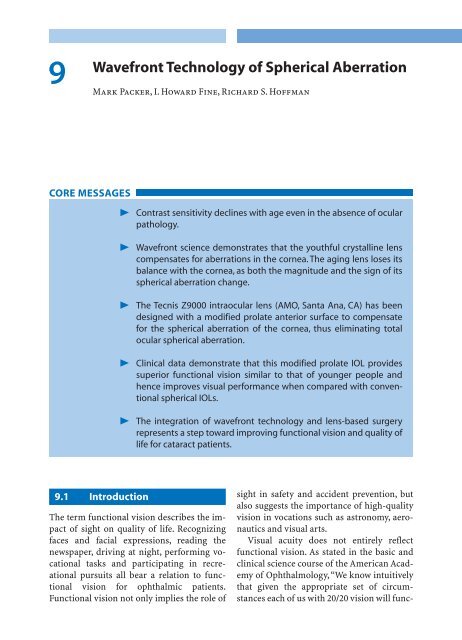Refractive Lens Surgery
Refractive Lens Surgery
Refractive Lens Surgery
Create successful ePaper yourself
Turn your PDF publications into a flip-book with our unique Google optimized e-Paper software.
9<br />
CORE MESSAGES<br />
Wavefront Technology of Spherical Aberration<br />
Mark Packer, I. Howard Fine, Richard S. Hoffman<br />
9.1 Introduction<br />
2 Contrast sensitivity declines with age even in the absence of ocular<br />
pathology.<br />
2 Wavefront science demonstrates that the youthful crystalline lens<br />
compensates for aberrations in the cornea. The aging lens loses its<br />
balance with the cornea, as both the magnitude and the sign of its<br />
spherical aberration change.<br />
2 The Tecnis Z9000 intraocular lens (AMO, Santa Ana, CA) has been<br />
designed with a modified prolate anterior surface to compensate<br />
for the spherical aberration of the cornea, thus eliminating total<br />
ocular spherical aberration.<br />
2 Clinical data demonstrate that this modified prolate IOL provides<br />
superior functional vision similar to that of younger people and<br />
hence improves visual performance when compared with conventional<br />
spherical IOLs.<br />
2 The integration of wavefront technology and lens-based surgery<br />
represents a step toward improving functional vision and quality of<br />
life for cataract patients.<br />
The term functional vision describes the impact<br />
of sight on quality of life. Recognizing<br />
faces and facial expressions, reading the<br />
newspaper, driving at night, performing vocational<br />
tasks and participating in recreational<br />
pursuits all bear a relation to functional<br />
vision for ophthalmic patients.<br />
Functional vision not only implies the role of<br />
sight in safety and accident prevention, but<br />
also suggests the importance of high-quality<br />
vision in vocations such as astronomy, aeronautics<br />
and visual arts.<br />
Visual acuity does not entirely reflect<br />
functional vision. As stated in the basic and<br />
clinical science course of the American Academy<br />
of Ophthalmology,“We know intuitively<br />
that given the appropriate set of circumstances<br />
each of us with 20/20 vision will func-



